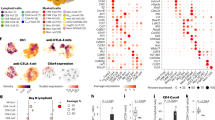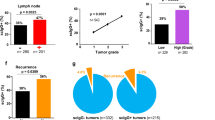Abstract
Stimulation of monocytes by interaction of monoclonal antibodies (mAbs) with Fc gamma receptors (FcγRs) results in the activation of various monocyte effector functions. In the present investigation we show that the anti-Lewis Y (LeY) anti-tumour mAb ABL 364 and its mouse/human IgG1 chimaera induce both antibody-dependent cellular cytotoxicity (ADCC) and the release of tumour necrosis factor α (TNF-α) during mixed culture of monocytes with LeY+ SKBR5 breast cancer cells in vitro. Although anti-LeY mAb-mediated TNF-α release paralleled ADCC activity, cytokine release required a higher concentration of sensitizing mAb than the induction of cytolysis. The determination of the FcγR classes involved in the induction of the distinct effector functions showed that anti-LeY mAb-induced cytolysis was triggered by interaction between anti-LeY mAbs and FcγRI. In contrast, mAb-induced TNF-α release mainly depended on the activation of monocyte FcγRII. Neutralization of TNF-α showed no influence on monocyte ADCC activity towards SKBR5 target cells. Our data indicate an independent regulation of anti-LeY mAb induced effector functions of ADCC and TNF-α release which seemed to be triggered by activation of different types of FcγR. © 2000 Cancer Research Campaign
Similar content being viewed by others
Article PDF
Change history
16 November 2011
This paper was modified 12 months after initial publication to switch to Creative Commons licence terms, as noted at publication
References
Blaszczyk-Thurin M, Thurin J, Hindsgaul O, Karlsson KA, Steplewski Z and Koprowski H (1987) Y and blood group B type 2 glycolipid antigens accumulate in a human gastric carcinoma cell line as detected by monoclonal antibody. J Biol Chem 262: 372–379
Bonta IL and Ben Efraim S (1993) Involvement of inflammatory mediators in macrophage antitumor activity. J Leukoc Biol 54: 613–626
Boot JHA, Geerts MEJ and Aarden LA (1989) Functional polymorphisms of Fc receptors in human monocyte-mediated cytotoxicity towards erythrocytes induced by murine isotype switch variants. J Immunol 142: 1217–1223
Bungard S, Flieger D, Schweitzer S, Sauerbruch T and Spengler U (1998) The combination of interleukin-2 and interferon alpha effectively augments the antibody-dependent cellular cytotoxicity of monoclonal antibodies 17-1A and BR55-2 against the colorectal carcinoma cell line HT29. Cancer Immunol Immunother 46: 213–220
Calzada-Wack JC, Frankenberger M and Ziegler Heitbrock HWL (1996) Interleukin-10 drives human monocytes to CD16 positive macrophages. J Inflamm 46: 78–85
Cassel DL, Keller MA, Surrey S, Schwartz E, Schreiber AD, Rappaport EF and McKenzie SE (1993) Differential expression of FcγRIIA, FcγRIIB and FcγRIIC in hematopoietic cells: analysis of transcripts. Mol Immunol 30: 451–460
Co MS, Baker J, Bednarik K, Janzek E, Neruda W, Mayer P, Plot R, Stumper B, Vasquez M, Queen C and Loibner H (1996) Humanized anti-Lewis Y antibodies: in vitro properties and pharmacokinetics in rhesus monkeys. Cancer Res 56: 1118–1125
Davenport RD, Burdick M, Strieter RM and Kunkel SL (1994) Monocyte chemoattractant protein production in red cell incompatibility. Transfusion 34: 16–19
Debets JMH, Winkel van de JGJ, Ceuppens JL, Dieteren IEM and Buurman WA (1990) Cross-linking of both FcγRI and FcγRII induces secretion of tumor necrosis factor by human monocytes, requiring high affinity Fc-FcγR interactions. J Immunol 144: 1304–1310
DeMarco R, Ensor JE and Hasday JD (1992) Tumor-stimulated release of TNF-α by human monocyte-derived macrophages. Cell Immunol 140: 304–318
Deo YM, Graziano RF, Repp R and Winkel van de JGJ (1997) Clinical significance of IgG Fc receptor and FcγR-directed immunotherapies. Immunol Today 18: 127–135
Guyre PM, Graziano RF, Vance BA, Morganelli PM and Fanger MW (1989) Monoclonal antibodies that bind to distinct epitopes on FcγRI are able to trigger receptor function. J Immunol 143: 1650–1655
Herrmann F, Vos de S, Brach M, Riedel D, Lindemann A and Mertelsmann R (1992) Secretion of granulocyte-macrophage colony-stimulating factor by human blood monocytes is stimulated by engagement of Fcγ receptors type I by solid-phase immunoglobulins requiring high-affinity Fc-Fcγ receptor type I interactions. Eur J Immunol 22: 1681–1685
Jänicke R and Männel DN (1990) Distinct tumor cell membrane constituents activate human monocytes for tumor necrosis factor synthesis. J Immunol 144: 1144–1150
Ling ZD, Ziltener HJ, Webb BT and Matheson DS (1990) Aggregated immunoglobulin and Fc fragment of IgG induce IL6-release from human monocytes. Cell Immunol 129: 95–103
Lubeck MD, Steplewski Z, Baglia F, Klein MH, Dorrington KJ and Koprowski H (1985) The interaction of murine IgG subclass proteins with human monocyte Fc receptors. J Immunol 135: 1299–1304
Marsh CB, Gadek JE, Kindt GC, Moore SA and Wewers MD (1995) Monocyte Fcγ receptor cross-linking induces IL-8 production. J Immunol 155: 3161–3167
Munn DH, McBride M and Cheung NKV (1991) Role of low affinity Fc receptors in antibody-dependent tumor cell phagocytosis by human monocyte-derived macrophages. Cancer Res 51: 1117–1123
Petroni KC, Shen L and Guyre PM (1988) Modulation of human polymorphonuclear leukocyte IgG Fc receptors and Fc receptor-mediated functions by IFN-γ and glucocorticoids. J Immunol 140: 3467–3472
Salmon JE, Millard SS, Brogle NL and Kimberly RP (1995) Fc gamma receptor IIIb enhances Fc gamma receptor IIa function in an oxidant-dependent and allele-sensitive manner. J Clin Invest 95: 2877–2885
Schlimok G, Pantel K, Loibner H, Fackler-Schwalbe I and Rietmüller G (1995) Reduction of metastatic carcinoma cells in bone marrow by intravenously administered monoclonal antibody: towards a noval surrogate test to monitor adjuvant therapies of solid tumours. Eur J Cancer 31A: 1799–1803
Scholz D, Lubeck M, Loibner H, McDonald-Smith J, Kimoto Y, Koprowski H and Steplewski Z (1991) Biological activity in the human system of isotype variants of oligosaccharide-Y-specific murine monoclonal antibodies. Cancer Immunol Immunother 33: 153–157
Shaw DR, Kahazaeli MB and LoBuglio AF (1988) Mouse/human chimeric antibodies to a tumor-associated antigen: biologic activity of the four human IgG subclasses. J Natl Cancer Inst 80: 1553–1559
Steplewski Z, Blaszczyk-Thurin M, Lubeck M, Loibner H, Scholz D and Koprowski H (1990) Oligosaccharide Y specific monoclonal antibody and its isotype switch variants. Hybridoma 9: 201–210
Tax WJM, Frenken LA, Tamboer WPM, Jacobs CWM, Frenken LAM and Koene RAP (1997) Role of polymorphic Fc receptor FcγRIIa in cytokine release and adverse effects of murine IgG1 anti-CD3/T cell receptor antibody (WT31). Transplantation 63: 106–112
Thom D, Powell AJ, Lloyd CW and Rees DA (1977) Rapid isolation of plasma membranes in high yield from cultured fibroblasts. Biochem J 168: 187–194
Trevani AS, Andonegui GA, Isturiz MA, Schatner M, Serebrinsky G and Geffner JR (1994) Effect of proteolytic enzymes on neutrophil Fc gamma RII activity. Immunology 82: 632–637
Vossebeld PJ, Kessler J, Borne von dem AE, Roos D and Verhoeven AJ (1995) Heterotypic Fc gamma R clusters evoke a synergistic Ca2+ response in human neutrophils. J Biol Chem 270: 10671–10679
Wing MG, Moreau T, Greenwood J, Smith RM, Hale G, Isaacs J, Waldmann H, Lachmann PJ and Compston A (1996) Mechanism of first-dose cytokine-release syndrome by CAMPATH 1-H: involvement of CD16 (FcγRIII) and CD11a/CD18 (LFA-1) on NK cells. J Clin Invest 98: 2819–2826
Winkel van de JGJ, Boonen GJJC, Janssen LW, Vlug A, Hogg N and Tax WJM (1989) Activation of two types of Fc receptors, FcγI-R and FcγII-R, in human monocyte cytotoxicity to sensitized erythrocytes. Scand J Immunol 29: 23–31
Author information
Authors and Affiliations
Rights and permissions
From twelve months after its original publication, this work is licensed under the Creative Commons Attribution-NonCommercial-Share Alike 3.0 Unported License. To view a copy of this license, visit http://creativecommons.org/licenses/by-nc-sa/3.0/
About this article
Cite this article
Dettke, M., Loibner, H. Different types of FC γ -receptors are involved in anti-Lewis Y antibody induced effector functions in vitro. Br J Cancer 82, 441–445 (2000). https://doi.org/10.1054/bjoc.1999.0940
Received:
Revised:
Accepted:
Published:
Issue date:
DOI: https://doi.org/10.1054/bjoc.1999.0940



